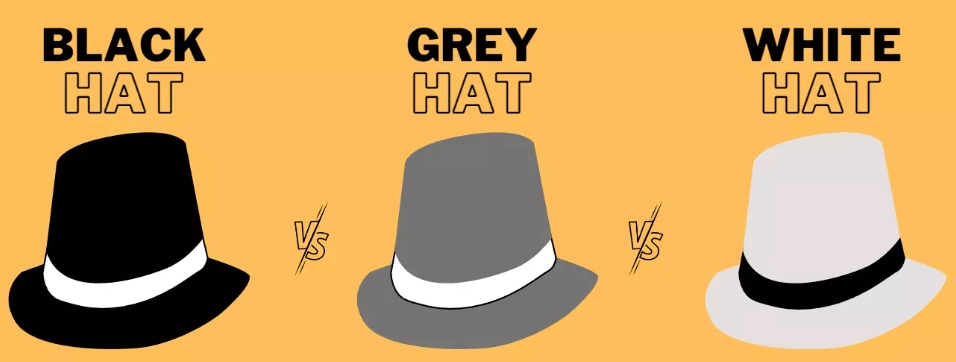What Is Grey Hat SEO?
Grey hat SEO is a type of SEO that mixes techniques from both white hat and black hat SEO. It’s basically the middle road in search engine optimization strategies. For example, you might follow the white hat approach by creating valuable, high-quality content, which is a good practice. However, then you might switch to a black hat tactic, such as buying backlinks to boost that content, which isn’t recommended by search engines like Google.

This blend can make grey hat SEO appealing because it can potentially improve your site’s ranking in search results more quickly than using only white hat techniques. A common example of grey hat SEO is when you reach out to authoritative websites, asking them to link back to your content. This isn’t exactly breaking the rules set out in search engine guidelines, but it’s also not the most transparent way to build backlinks, as Google prefers links to be shared naturally through the Google search console.
Why Is Grey Hat SEO Important?
Grey hat SEO holds a unique place as it helps bridge the gap between white hat SEO techniques and black hat SEO tactics.

Grey hat SEO is often used because it can provide quick improvements in a site’s ranking. For example, someone might slightly tweak the content of different pages to target specific keywords more effectively. This isn’t as manipulative as black hat SEO techniques like keyword stuffing, but it’s more aggressive than the typical white hat SEO technique of naturally incorporating keywords based on user intent.
Understanding grey hat SEO is essential because it helps you:
- Recognize and Avoid Risky Practices: Knowing what constitutes grey hat SEO can help you stay away from tactics that could potentially harm your site’s long-term health. For example, using cloaked URLs might give a temporary boost, but it risks penalties from search engines.
- Ensure Compliance with SEO Contractors: By being informed, you can ensure that the contractors you hire aren’t inadvertently using grey hat SEO tactics that could jeopardize your site.
- Identify Competitors’ Tactics: Recognizing grey hat techniques can also be a strategic tool in understanding how competitors might be bending the rules to gain an advantage.
What Are Some Grey Hat SEO Examples?
Grey hat SEO includes multiple tactics that tread the line between the clear-cut acceptable white hat techniques and the risky black hat tactics.
Here are some common examples of grey hat SEO techniques used to improve search engine rankings, showing how they attempt to make the best of both tactics:
Commenting on Blogs for Backlinks
This grey hat SEO tactic involves leaving comments on blog posts in a way that could generate backlinks to your site. Instead of blatantly asking for a link, you might mention something valuable about the article and add insight that relates to your own content.
With this method, you hope that readers or the blog owner will visit your site or link back to it because of your valuable contribution. It’s subtle yet strategic, using community engagement to build links.
Cold Emailing for Link Building
Reaching out to potential link sources via cold emails is another common grey hat practice. This isn’t as aggressive as buying links because there’s no money involved; instead, it’s about initiating contact in hopes of establishing a link-sharing arrangement.
Tools like Rapportive can be used to gather information about the recipient, making your approach more personalized and increasing the chances of a positive response.
Utilizing Low-Quality Websites for Links
This grey hat technique involves placing links on lower-quality websites to boost your own site’s domain authority. While not as severe as using a private blog network (PBN), it still poses risks as these sites might not meet high content standards and could eventually be penalized by Google.
This approach is aimed at quickly improving your PageRank to outpace competitors but can lead to problems with search engine penalties if not managed carefully.
Grey Hat SEO vs. White Hat SEO vs. Black Hat SEO
To understand SEO practices, think of a spectrum with white hat SEO on one end and black hat SEO on the other. Grey hat SEO sits in the middle, combining tactics from both ends to push search engine rankings while bending the rules just enough to avoid major penalties.

White Hat SEO
White Hat SEO tactics represent the most ethical practices in SEO. It strictly adheres to search engine guidelines and focuses on providing a great user experience. Examples of white hat SEO techniques include creating original, high-quality content that genuinely helps readers, building links through legitimate relationships (like guest blogging), and ensuring your website is easy to navigate and fast.
Black Hat SEO
Black Hat SEO, on the other hand, involves tactics that are explicitly against search engine guidelines. Black hat practitioners aim for quick wins, often at the expense of long-term penalties. Common black hat SEO techniques include using automated software to create backlinks, stuffing content with excessive keywords, creating deceptive doorway pages, or using cloaked URLs to trick both users and search engines.
These practices can lead to severe penalties from search engines, such as Google and Bing, resulting in your site being demoted or completely removed from search results.
Grey Hat SEO
Grey hat SEO is where the lines start to blur. This approach uses techniques that aren’t outright prohibited by search engine guidelines but are still risky. For example, grey hat SEO might involve slightly tweaking the content of different pages to target specific, high-value keywords, or it could mean purchasing backlinks in a way that tries to appear natural.
While not as dangerous as black hat SEO practices, grey hat SEO still carries risks of penalties if search engines decide that the tactics used are deceptive or manipulative.
Thus, to compare, white hat techniques are the safest and most reliable for building a reputable online presence, black hat SEO could potentially destroy your site’s credibility, and grey hat SEO exists in a delicate balance between the two, providing opportunities but also requiring caution.
Grey Hat SEO Tactics You Must Avoid
While grey hat SEO can be tempting, some tactics are too risky and can slide into black hat territory if not handled carefully. Here are some grey hat SEO tactics you should avoid:

Buying Backlinks
Buying backlinks is a common grey hat tactic where you pay other sites to link back to your content. While this might boost your site’s ranking temporarily, it violates Google’s Webmaster Guidelines and can lead to penalties. Moreover, this practice can be quite costly, with prices averaging around $360 per link.
Alternative Approach: Instead of buying links, consider guest blogging. This legitimate strategy involves writing articles for other reputable websites in your niche, which can then link back to your site naturally.
Keyword Stuffing
In the past, filling pages with the same keywords could improve rankings. However, Google’s algorithms have evolved and now penalize this practice known as keyword stuffing. It makes content unreadable and detracts from the user experience, potentially hurting your site’s ranking.
Alternative Approach: Focus on creating comprehensive content that naturally incorporates keywords and covers relevant subtopics. Utilize tools like Google’s “People Also Ask” to understand what related information users are searching for, and include these elements in your content to organically attract search traffic.
Negative SEO
Negative SEO involves sabotaging a competitor’s rankings by creating spammy, irrelevant links to their site. While some believe this can divert traffic to their own site, Google is increasingly capable of detecting and disregarding such tactics.
Alternative Approach: A better strategy is to concentrate on producing high-quality content that genuinely matches the search intent of your audience. Optimize your content for the three C’s of search intent, i.e., content type, format, and angle, to naturally outperform competitors in search results.
Spun or Auto-Generated Content
Using software to spin existing content into new articles is a grey hat tactic that risks producing low-quality, incoherent material. While AI and content generation technologies have improved, they still can’t match the authenticity and depth of human-written content.
Alternative Approach: Invest time in the perspective technique, where you develop multiple pieces of content around a single theme from various angles. This approach, while more labor-intensive, results in unique, high-quality content that can attract genuine backlinks and reader engagement.
Using Private Blog Networks (PBNs)
PBNs are networks of websites created solely to link back to a main site to manipulate SEO rankings. This grey hat tactic is risky as it can be easily recognized as a link scheme by Google, leading to severe penalties.
Alternative Approach: The safer route is to build quality links through genuine relationships and collaborations. Participate in industry forums, contribute to discussions, and connect with peers in your field to naturally earn links that benefit your SEO efforts.
Conclusion
Grey hat SEO represents a middle ground between white hat and black hat techniques. While it can provide faster results than strictly white hat tactics, it carries risks that can compromise a site’s long-term health and credibility. By understanding and avoiding the more dangerous grey hat tactics, you can optimize your website effectively and ethically so that your online presence is both solid and sustainable.







